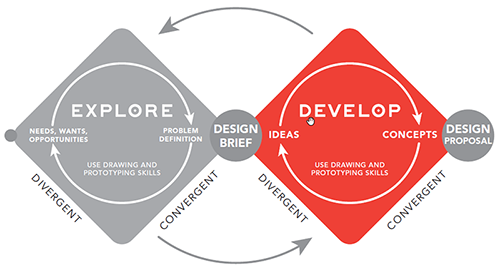Topic 1: Exploring
sustainable design opportunities
 |
How are sustainable design opportunities identified? |
| |
In this topic, you will: |
 |

|
Identify a design opportunity |

|
recognise that design opportunities may be explored to
> fill a gap in the market
> create a market for something that previously did not exist
> improve human well-being |

|
consider a designers responsibility to the community and to other designers |

|
recognise that sustainable design is influenced by decisions at local, national and global levels and as an approach seeks to support human well-being while balancing the impact of
> economic sustainability
> social sustainability
> ecological sustainability |

|
analyse examples of successful design opportunities, e.g. portable digital devices, digital games and apps, fashion items, and household products, by considering the nature of the design life cycle:
> launch — when a design is introduced to the market
> growth — when the market has accepted the design and sales increase
> maturity — when the sales have reached their peak
> decline — when sales decline as the design reaches saturation point |

|
analyse unsustainable design approaches that focus on a linear take, make and dispose model |

|
compare sustainable design approaches, e.g. green design, sustainable fashion, sustainable architecture, sustainable graphic design, to identify similarities and differences |
 |
investigate existing products, services and environments to identify how they could be redesigned to improve their economic, social or ecological sustainability and therefore create a new design opportunity |

|
examine selected products, services or environments to define redesign opportunities
> determine the range of stakeholders that would be associated with a redesigned product, service or environment
> identify aesthetic, cultural, economic, social and technical features |
Topic 2 - Developing a redesign
 |
How do designers redesign for sustainability? |
| |
In this topic, you will: |
 |

|
consider the whole life cycle of potential products, environments and services |

|
recognise that designs may affect economic, social and ecological sustainability in ways that are unpredictable and beyond the control of the designer such as software, materials and production decisions or how stakeholders use the designed solution |

|
recognise how design decisions contribute to planned obsolescence (to artificially limit the useful life), which is a key strategy in increasing consumption and economic growth |

|
consider how design decisions either encourage or discourage obsolescence including
> function, e.g. new designs that do something better, therefore making the existing designs inferior
> quality, e.g. the time taken to wear out or break
> desirability, e.g. something is considered out of fashion by the arrival of newer and more exciting options |

|
recognise circular design methods including:
> considering the future of a design beyond a single design life cycle for a specific user
> creating more value by enabling multiple uses and users of a design
> focusing on increasing positive impacts rather than reducing negative impacts |

|
apply circular design methods to devise ideas in response to a redesign opportunity, e.g.
> a product that could be continuously re-purposed in a ‘closed loop’
> a service that could replace a product solution, e.g. a personal mobility service rather than a new car
> a product or environment that could add value to the ecosystem, e.g. biodegradable products that break down, just as in nature
> a service or environment that could be renewed, e.g. able to be upgraded, reprogrammed or refurbished for indefinite service |

|
devise ideas by using divergent thinking strategies, schematic sketches and ideation sketches and/or low-fidelity prototypes to represent a range of redesign ideas |

|
consult with relevant stakeholders to test ideas and identify the potential of opportunities to
> fill a gap in the market
> create a market for something that previously did not exist
> improve human well-being |
 |
use SLI to evaluate your ideas against your design criteria |
 |
synthesise your design ideas using SCAMPER |
 |
use techniques including ideation sketches, illustrations, diagrams, photographs, motion graphics, interactive simulations and physical low-fidelity prototypes to present your ideas and final concept design |
 |
use annotations to explain decisions and record the evaluation of your ideas and design concepts. |
|
